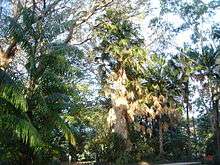Livistona saribus
Livistona saribus, is a species of palm tree found in Southeast Asia (Cambodia, Laos, Thailand, Vietnam, Borneo, Java. Peninsular Malaysia and the Philippines). It is reportedly naturalized in the Society Islands of French Polynesia and also in the Guangdong and Yunnan regions of China.[2]
| Taraw palm | |
|---|---|
 | |
| Scientific classification | |
| Kingdom: | Plantae |
| Clade: | Tracheophytes |
| Clade: | Angiosperms |
| Clade: | Monocots |
| Clade: | Commelinids |
| Order: | Arecales |
| Family: | Arecaceae |
| Genus: | Livistona |
| Species: | L. saribus |
| Binomial name | |
| Livistona saribus | |
| Synonyms[1] | |
| |
Livistona saribus produces blue fruits, and is cold hardy to -4 degrees Celsius.[3][4] It has spines along the leaf stems which resemble shark teeth. The large palm grows to from 12 to 25m in height and grows in dense/closed and secondary/disturbed forests of tropical Southeast Asia. [5]
One of the common names of the palm is taraw. In Cambodia it has the name triëk, its leaves are used for thatch on huts and to make hats.[5]
References
- The Plant List
- Kew World Checklist of Selected Plant Families, Livistona saribus
- Chevalier, Auguste Jean Baptiste. 1919. Bulletin Economique (de l'Indochine) 21(137): 501–502, Livistona saribus
- Loureiro, João de. 1790. Flora cochinchinensis: sistens plantas in regno Cochinchina nascentes. Quibus accedunt aliæ observatæ in Sinensi imperio, Africa Orientali, Indiæque locis variis. Omnes dispositæ secundum systema sexuale Linnæanum. Ulyssipone 1: 212, Corypha saribus
- Pauline Dy Phon (2000). Plants Utilised In Cambodia/Plantes utilisees au Cambodge. Phnom Penh: Imprimerie Olympic. p. 406.
This article is issued from Wikipedia. The text is licensed under Creative Commons - Attribution - Sharealike. Additional terms may apply for the media files.